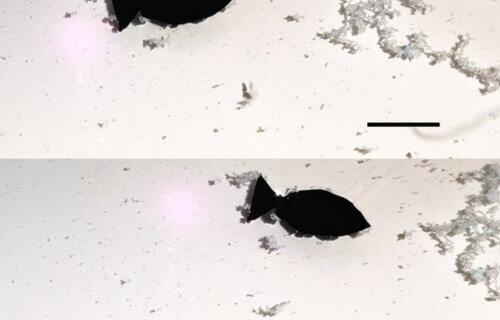
SICHUAN, China — A robotic fish that swims around sucking up microplastics from waters has been created by scientists in China. The tiny machine ‘”wiggles” its body and “flap”‘ its fins just like the real thing.
The fish robot measures just half-an-inch from nose to tail. Rapidly turning a near-infrared light laser on and off at the tail propels it forward. It was inspired by mother-of-pearl shell, and could help save the planet.
In experiments the robot moved nearly three body lengths per second — a record for soft marine robots. It reached the same speed as active phytoplankton. The untethered device repeatedly adsorbed nearby polystyrene microplastics and transported them elsewhere.
Incredibly, the device can also “heal” itself after being cut, still maintaining its ability to pick up the debris. Its durability and speed make it ideal for monitoring microplastics and other pollutants in harsh aquatic environments.
“The proof-of-concept robot is demonstrated to emphasize its maximum swimming speed of 2.67 body length per second, whose speed is comparable to that of plankton, representing the outperformance of most artificial soft robots,” the authors write in their paper. “Furthermore, the robot can stably absorb pollutants and recover its robustness and functionality even when damaged.”
Microplastics are found nearly everywhere on Earth and can be harmful to animals if ingested. They are notoriously difficult to remove from the environment, especially once settled into nooks and crannies at the bottom of rivers, streams, lakes or oceans.
Could this light-activated robotic fish be the key for healthier waters?
Traditional materials used for soft robots are hydrogels and elastomers, which are easily damaged in water. But mother-of-pearl, also known as nacre, is strong and flexible. It is found on the inside of clam shells. It is made up of layers that have a microscopic gradient — one side with lots of calcium carbonate composites and the other with a silk protein filler.
The scientists developed a similar structure to make the durable and bendable material for their fish. They first made nanosheets from a cocktail of chemicals including graphene, the toughest material on Earth. Solutions were incorporated with different concentrations into polyurethane latex mixtures.
A layer-by-layer assembly method formed an ordered concentration gradient, just like mother-of-pearl. The Chinese team formed the robot out of the new material.
“This study breaks the mutual exclusivity of functional execution and fast locomotions,” the authors write. “We anticipate our nanostructural design will offer an effective extended path to other integrated robots that required multifunction integration.”
The robot is described in the American Chemical Society’s journal Nano Letters.
South West News Service writer Mark Waghorn contributed to this report.

I wonder if whales can digest these too! (sarc)